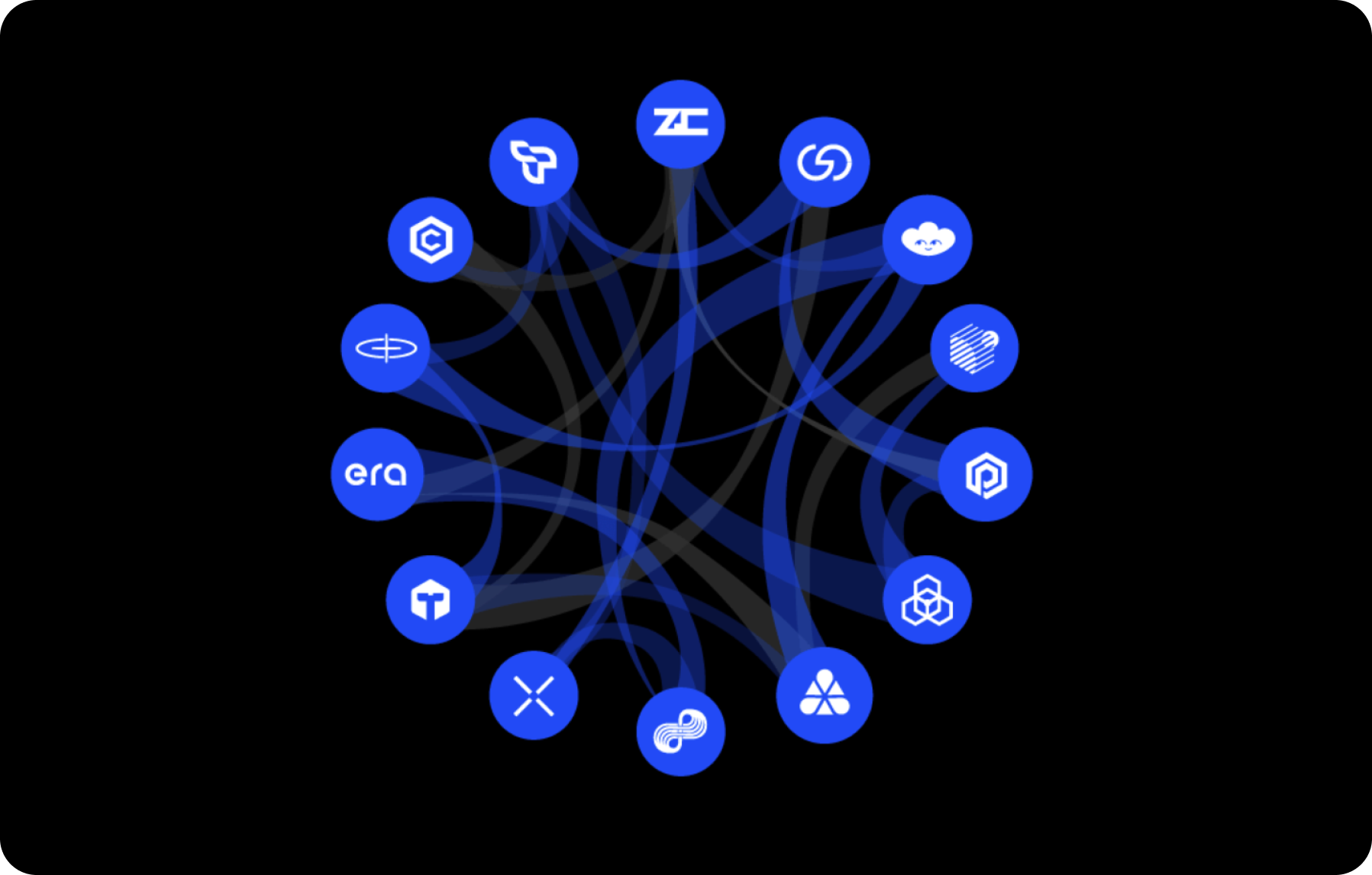ZKSync Project Overview

Key Insights
- ZKSync implements the Layer 2 concept, which aims to offload the Ethereum core network (Layer 1) by moving computation and storage to the second layer.
- ZKSync uses zk rollups technology to scale Ethereum, unlike Optimistic Rollups, which assume the transactions as correct until proven otherwise.
- ZKSync demonstrates high performance with throughput of up to 2000 transactions per second (TPS) at Layer 2.
A fundamental analysis of ZKSync platform, its architecture, features, security, functionality and much more.
We advise closely monitoring this project updates and evaluating its potential in the context of Ethereum's growing scaling needs.
What Is ZKSync
ZKSync is an innovative Ethereum network scaling solution designed to eliminate the performance bottlenecks and high fees that traditionally limit the capabilities of the core network.

Based on advanced zero knowledge proof technology, ZKSync uses zk rollups to combine multiple transactions into a single packet, which is then processed and written to the Ethereum blockchain, providing high speed and low cost transactions without compromising security and decentralization.
Mission of ZKSync is to create an affordable and scalable ecosystem for users and developers that can support the growing needs of DeFi applications, NFT platforms and other innovative projects on the Ethereum blockchain.
With full compatibility with Ethereum, ZKSync provides a simple and efficient way to move assets and applications to the second layer, avoiding congestion on the core network and ensuring smooth operation even with high transaction volumes.

Key Features of ZKSync
- Scalability
The ability to process thousands of transactions per second, far exceeding the current capabilities of the Ethereum core network.
- Low fees
Through the use of zk rollups, transactions cost users significantly less than Layer 1, making ZKSync attractive to the masses.
- Security and decentralization
The entire transaction verification process takes place on Ethereum, maintaining the high level of security and trust inherent in the underlying network.
- Support for smart contracts
ZKSync supports the development and execution of smart contracts, providing ample opportunities for creating dApps.
ZKSync Project Architecture
In the ZKSync project, Layer 2 serves to increase network bandwidth and reduce transaction costs while maintaining the security and decentralization provided by the Ethereum core network.
ZKSync Architecture Description
The ZKSync architecture includes two main layers:
- Core Network (Layer 1)
Ethereum serves as the base layer where transaction data is stored and validation is performed. Layer 1 provides the decentralization and security necessary for trust in the system.
- Second-order layer (Layer 2)
ZKSync functions at this layer where basic computation and transaction aggregation are performed. Layer 2 processes transactions, generates packets (rollups), and transmits them to the core network for verification.
Roles and Node Interactions
The following key nodes participate in ZKSync:
- Sequencers
Nodes that collect and organize transactions, create rollups, and send them to the core network for verification.
- Verifiers
Nodes that verify the correctness of the zero knowledge proofs associated with the transactions in the rollups, ensuring that they conform to consensus rules.
ZKSync Protocols and Algorithms
- Zero Knowledge Proof
ZKSync uses zero knowledge proof technology to prove the correctness of transactions without having to disclose all information. This ensures data security and reduces computational overhead.
- Rollup mechanisms
Rollups aggregate multiple transactions into a single packet that is transmitted to the core network. This reduces the load on Layer 1 as a single rollup replaces multiple individual transactions.
- Data security and validation
Data validation is performed using zero knowledge proofs that validate the correctness of transactions. The data is stored on the Ethereum core network, which maintains a high level of security and decentralization.
ZKSync Functionality
- Smart contracts support
ZKSync supports the execution of smart contracts at the second-order level. Smart contracts are developed in the Zinc programming language, which is compatible with Solidity used on the Ethereum core network.
Currently, developing smart contracts on ZKSync requires the use of specialized development tools and environments, such as the ZKSync SDK and contract compilation and deployment tools.
- Multi-Activity Support
ZKSync supports a variety of token types, including standard ERC-20 tokens and NFT tokens (ERC-721). This allows users to work with a wide range of digital assets and dApps, supporting the creation, transfer and management of tokens and NFTs within the ZKSync platform.
- Switching and interoperability
ZKSync provides compatibility with the Ethereum core network, allowing assets and data to be easily transferredbetween Layer 1 and Layer 2.

The project also supports integration with other blockchain networks and services through standardized interfaces and protocols, enabling interoperability with various dApps and platforms.
ZKSync Performance and Scalability
- Test Metrics
Transaction confirmation times range from a few seconds to a minute, depending on network load and the timing of the packet's inclusion in the Ethereum blockchain. Transaction processing latency also remains low, ensuring fast processing of requests.
- Optimization of resource utilization
ZKSync optimizes the use of computing resources by aggregating transactions into rollups. This reduces the amount of data that needs to be processed and stored on the underlying Ethereum blockchain.
As a result, computational power and storage space requirements are reduced, contributing to a more efficient system.
- Fee analysis
Transaction fees on the ZKSync network are significantly lower than on the Ethereum main network due to the rollups model, which allows costs to be shared across multiple transactions.
Fees are distributed to all participants using the network, which reduces the cost to each individual user. The economic model of the network aims to minimize costs while maintaining sufficient security and efficiency.
ZKSync Security
- Security mechanisms
ZKSync applies zero knowledge proof (zk proof) principle to ensure the correctness and integrity of transactions without revealing data details. This confirms the correctness of transactions while minimizing computational load.
Standard techniques are used to protect against Sybil and DDoS attacks, such as requiring significant resources to participate in the ZKSync network and monitoring mechanisms to detect anomalous activity.
- Risks and vulnerabilities
Potential risks include possible vulnerabilities in the implementation of zero knowledge proof and bugs in the smart contracts code. There is also a risk of attacks on the network node infrastructure.
Mitigation methods include regular protocol updates, use of node attack defenses, and thorough testing and auditing of code to identify and remediate vulnerabilities.
- Security auditing and testing
ZKSync has undergone several independent security audits that cover both protocols and smart contracts implementations. The results of the audits include recommendations to improve security, address identified vulnerabilities, and ensure compliance with security standards.
The results of the audits are published to ensure transparency and trust in the system.
ZKSync Ecosystem and Integration
- Integrations with existing solutions
ZKSync is integrated with various dApps and DeFi projects such as Uniswap and Curve. These integrations allow users to interact with ZKSync-based platforms, providing access to token exchange, liquidity, and other financial services.
ZKSync also supports interoperability with NFT platforms and various blockchain services through standardized interfaces.
- Community and developer support
ZKSync supports developers through the provision of SDKs, documentation and use cases. Community interaction is done through formal channels such as forums, chat rooms, and social media.
Documentation includes integration guides, code samples, and tools for developing ZKSync-based smart contracts and applications.
ZKSync Competitive Analysis
- Comparison with alternatives
Compared to Arbitrum, which uses similar Optimistic Rollups technology, ZKSync offers lower fees and lower transaction latency thanks to zk proofs, which allow transactions to be verified immediately without the need for a challenge phase.
- Unique features and benefits
ZKSync sets itself apart from the competition by utilizing zero knowledge proof principle, which provides lower fees and faster transaction processing speeds than Optimistic Rollups. In addition, zk rollups allow transactions to be processed and validated more efficiently, minimizing latency.
Compared to Arbitrum, ZKSync offers faster transaction verification and less load on the Ethereum core network, which also contributes to higher security and fewer challenges.
Summary
The ZKSync project architecture includes efficient resource utilization and fast transaction processing, making it attractive to a wide range of users and developers.
Integrations with various dApps and DeFi projects confirm its active role in the Ethereum ecosystem, and developer support through SDKs and documentation further develops the platform.
An investment in ZKSync may be promising, especially in light of its active development and expanding capabilities.
Users can get any cryptocurrency for fiat or crypto on SimpleSwap.
The information in this article is not a piece of financial advice or any other advice of any kind. The reader should be aware of the risks involved in trading cryptocurrencies and make their own informed decisions. SimpleSwap is not responsible for any losses incurred due to such risks. For details, please see our Terms of Service.


